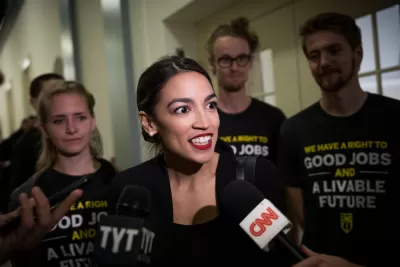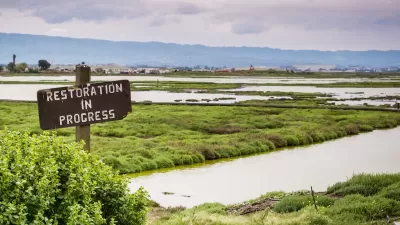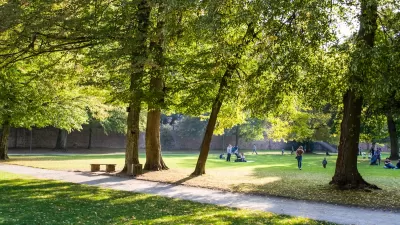If it emulated and adapted the scope of its predecessor, the Green New Deal could transform the country in fundamental ways, with builders, planners, and architects playing central roles.

Two futures may be in store for the country, Kelsey Campbell-Dollaghan writes. "Escalating storms, floods, droughts, mass migration, food scarcity, and economic instability could dramatically alter the physical landscape and economy." Or, more optimistically, "A national effort to retrofit millions of buildings and rethink the way communities are designed could help Americans withstand the ravages of climate change and make the country more equitable."
Discussing issues of bureaucratic reform, land use, architecture, labor, and equity, Campbell-Dollaghan outlines what it might take to implement the Green New Deal. That includes environmental retrofits for "tens of millions of houses and apartment buildings," an endeavor that would employ an immense workforce and necessitate a lot more federal oversight of local affairs.
The Green New Deal also bakes in an explicit focus on equity, with consequences for housing affordability and the workforce. "A renovation program on this scale could have many unintended effects" on vulnerable populations that policymakers would need to address.
Campbell-Dollaghan also discusses how the Green New Deal could truly engage architects and designers in the oft-talked about project of sustainable, equitable development. "The resolution poses an opportunity for architects and designers to reclaim their relevance to society, not as service providers for wealthy clients but as vocal leaders on major issues in the built world, like social justice and climate change."
FULL STORY: The Green New Deal could change the way America builds—here’s how

Alabama: Trump Terminates Settlements for Black Communities Harmed By Raw Sewage
Trump deemed the landmark civil rights agreement “illegal DEI and environmental justice policy.”

Planetizen Federal Action Tracker
A weekly monitor of how Trump’s orders and actions are impacting planners and planning in America.

The 120 Year Old Tiny Home Villages That Sheltered San Francisco’s Earthquake Refugees
More than a century ago, San Francisco mobilized to house thousands of residents displaced by the 1906 earthquake. Could their strategy offer a model for the present?

BLM To Rescind Public Lands Rule
The change will downgrade conservation, once again putting federal land at risk for mining and other extractive uses.

Indy Neighborhood Group Builds Temporary Multi-Use Path
Community members, aided in part by funding from the city, repurposed a vehicle lane to create a protected bike and pedestrian path for the summer season.

Congestion Pricing Drops Holland Tunnel Delays by 65 Percent
New York City’s contentious tolling program has yielded improved traffic and roughly $100 million in revenue for the MTA.
Urban Design for Planners 1: Software Tools
This six-course series explores essential urban design concepts using open source software and equips planners with the tools they need to participate fully in the urban design process.
Planning for Universal Design
Learn the tools for implementing Universal Design in planning regulations.
Clanton & Associates, Inc.
Jessamine County Fiscal Court
Institute for Housing and Urban Development Studies (IHS)
City of Grandview
Harvard GSD Executive Education
Toledo-Lucas County Plan Commissions
Salt Lake City
NYU Wagner Graduate School of Public Service





























